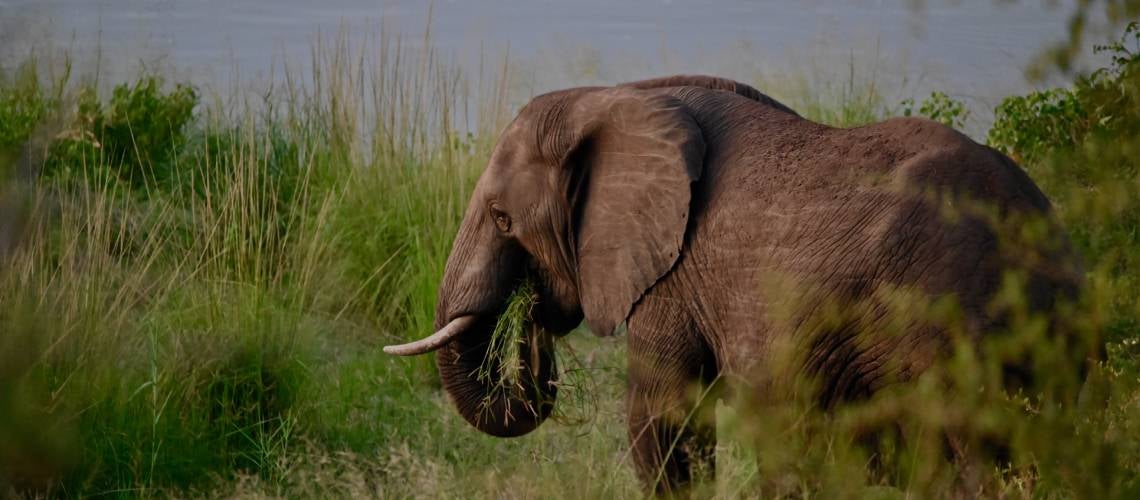 An elephant eating grass next to the Limpopo River in South Africa's Kruger National Park. Photo: Carine Durand/World Bank
An elephant eating grass next to the Limpopo River in South Africa's Kruger National Park. Photo: Carine Durand/World Bank
The need for awareness—and action—about the threat to biodiversity is greater than ever.
The world's biodiversity has been diminishing at an alarming rate—tens of thousands of animal and plant species have vanished because of human actions such as large-scale agriculture, overexploitation of natural resources, and climate change.
It is estimated that the overexploitation and degradation of the biodiversity ecosystems will result in the loss of 50% of Africa’s bird and mammal species, and 20-30% of lake productivity by the end of the century, as well as decline of wildlife and fisheries.
Source: The UN Environment Programme World Conservation Monitoring Centre (UNEP-WCMC), 2016.
Half of our ecosystems are under threat from biodiversity loss. Wetlands and river ecosystems are most at risk.
Why does it matter?
Rich, abundant biodiversity provides important socio-economic benefits, often in poor rural areas, contributing to job creation, poverty alleviation, climate resilience, and inclusive growth. Rivers, wetlands, and water towers are crucial ecological infrastructure for water security, food security, and sustainable economic development.
As the Secretariat of the Convention on Biological Diversity puts it, “The loss of biodiversity threatens our food supplies, opportunities for recreation and tourism, and sources of wood, medicines, and energy. It also interferes with essential ecological functions.”
The Cooperation in International Waters in Africa program built up a team dedicated to its work on deepening its approach to biodiversity and transboundary water matters.
The World Bank Group is the leading multilateral financier of biodiversity. In FY22, the Bank's biodiversity portfolio was $2.8 billion, up from $1.9 billion in FY21, supporting more than 100 active projects with direct investments into nature.
CIWA is exploring ways to better align its transboundary water cooperation efforts with biodiversity conservation goals, including identifying opportunities at the intersection of transboundary water management and freshwater biodiversity conservation.
That’s because rivers and other freshwater ecosystems are key to supporting biodiversity and the benefits of healthy, functional and connected natural systems—and cooperation over transboundary waters can contribute to these efforts.
Rivers deliver sediment to maintain riverbanks, floodplains, coastal dunes, and deltas. Wetlands are among the most biodiversity-rich ecosystems in the world, helping reduce flood risk, improve water purification and groundwater recharge, and support sustainable fishing.
Freshwater fish are essential for livelihoods, food security, and local economies. Sustainable groundwater supply is critical for Groundwater Dependent Ecosystems (GDEs), including riparian vegetation and grasslands, and indirectly sustains lakes and wetlands.
CIWA recently conducted a biodiversity assessment of its work in sub-Saharan Africa. It aimed to:
● Examine the role of rivers and other transboundary freshwater ecosystems in supporting biodiversity and services and benefits associated with healthy natural systems
● Identify the major threats to rivers and freshwater ecosystems
● Develop a methodology and approach in assessing CIWA program activities on their contribution to biodiversity (including the DPSIR - Drivers, Pressures, State, Impact, Responses- framework below from IUCN - International Union for Conservation of Nature)
● Present the findings and a conceptual framework for action for discussion with stakeholders in the region.
The assessment concluded that CIWA’s support of biodiversity-related activities provide both direct and indirect benefits to biodiversity conservation in sub-Saharan Africa.
Key direct benefits of CIWA activities to biodiversity conservation include facilitating integrated and innovative approaches to better understand the linkages between improved ecosystem integrity and river connectivity, the role of climate change adaptation in freshwater resource planning and management, and the provision of ecosystem services.
Key indirect benefits include strengthening river basin organizations (RBOs) and national water management agencies, supporting civil society organizations (CSOs) to facilitate evidence-based decision-making, developing platforms to share information, and supporting improved rural livelihoods to reduce unsustainable natural resource exploitation practices.
The assessment also highlighted the opportunity to develop a more structured, integrated approach to embedding biodiversity conservation considerations into the planning, design and implementation of CIWA’s activities and initiatives.
The assessment concluded that CIWA’s support of biodiversity-related activities provide both direct and indirect benefits to biodiversity conservation in sub-Saharan Africa.
Key direct benefits of CIWA activities to biodiversity conservation include facilitating integrated and innovative approaches to better understand the linkages between improved ecosystem integrity and river connectivity, the role of climate change adaptation in freshwater resource planning and management, and the provision of ecosystem services.
Key indirect benefits include strengthening river basin organizations (RBOs) and national water management agencies, supporting civil society organizations (CSOs) to facilitate evidence-based decision-making, developing platforms to share information, and supporting improved rural livelihoods to reduce unsustainable natural resource exploitation practices.
The assessment also highlighted the opportunity to develop a more structured, integrated approach to embedding biodiversity conservation considerations into the planning, design and implementation of CIWA’s activities and initiatives.
At COP15, in December 2022, nations adopted the Kunming-Montreal Global Biodiversity Framework agreeing to conserve and manage at least 30 percent of the world’s lands, inland waters, coastal areas and oceans. With emphasis on areas of particular importance for biodiversity and ecosystem functioning and services.
Potential opportunities for enhanced transboundary waters cooperation linked to biodiversity conservation that CIWA is considering include:
● Contributing to the improvement of the environmental, human, and economic health of Lake Victoria and its surrounding communities through a holistic, long-term basin-wide sanitation approach. Watch our video explainer:
● Modeling for improved decision making in the Niger’s Basin ecosystem. Watch our video:
● Making resilient investments for pro-poor livelihoods to increase benefits to communities while restoring and maintaining the biodiversity integrity of the Cubango-Okavango River Basin. Watch our video explainer:
● Determining options for a sustainable institutional mechanism to support cooperative transboundary management of the Senegalo-Mauritanian Aquifer Basin (SMAB) in western Sahel. Watch our video explainer:
● Improving the water resources knowledge and data management in the Great Limpopo Transfontier Conservation Area (GLTFCA). Watch our video explainer:
With climate change intensifying and especially affecting Africa, the need to incorporate biodiversity considerations into development projects is greater than ever.
Happy 30th Biodiversity Day!
The CIWA Program is in the process of the development of a Conceptual Framework for Action on Biodiversity Conservation and Transboundary Water Cooperation next FY23-24. Stay tuned!
RELATED LINKS
Publications/ Resources
CIWA Annual Report 2022
CIWA AT 10 Report
CIWA Learning Note: Uncovering the socio-economic potential of groundwater-dependent ecosystems in the Sahel
The Lake Chad Development and Climate Resilience Action Plan
World Bank Engagement in Transboundary Waters in West Africa: Retrospective and Lessons Learned
Navigating the Network: Stakeholder Mapping in Support of Investment Planning in the Cubango-Okavango River Basin
Realizing the Benefits of Transboundary Water Cooperation in the Cubango-Okavango River Basin
Addressing Poverty Through Multi-Sector Investments in the Cubango-Okavango River Basin
The Cubango-Okavango River Basin Multi-Sector Investment Opportunities Analysis
Fouta Djallon Water Atlas
Events
COP15: Nations Adopt Four Goals, 23 Targets For 2030 In Landmark N Biodiversity Agreement
UNEP Webpage On The UN Biodiversity Conference In December 2022
Blogs
Protecting Biodiversity through transboundary solutions in Africa
Enhancing Niger Basin’s Ecosystems through modeling and improved decisions making
On desertification and drought day, bringing integrated drought risks management at the forefront in southern Africa
CIWA Podcasts: Across the Pond
Conservation and Protection of the Cubango Okavango Basin in Southern Africa
Biodiversity and effective transboundary water cooperation program
Articles
Meet Great Limpopo TFCA Champion Piet Theron
Promote rural development communities around protected areas
Why should biodiversity be Africa's top priority?



Join the Conversation